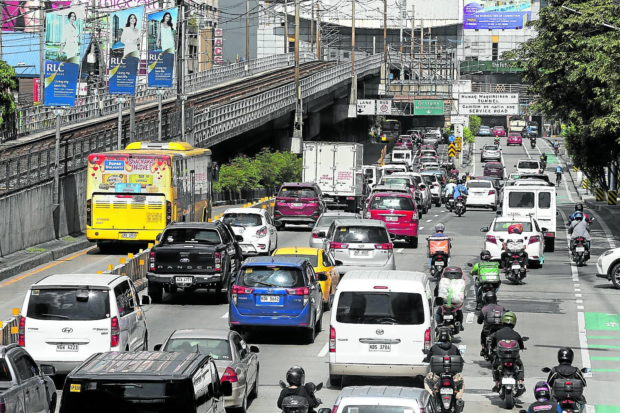
Besides the presence of the Omicron variant, increased mobility during the holidays contributed to the spike in COVID-19 cases, according to Dr. John Wong, a member of the DH Senior Technical Advisory Group. This photo was taken on Edsa in December 2021. (File photo by NIÑO JESUS ORBETA / Philippine Daily Inquirer)
MANILA, Philippines — The quick and sharp increase in COVID-19 infections may be a sign that the country is already dealing with the more transmissible Omicron variant, according to epidemiologist Dr. John Wong, a member of the DOH Senior Technical Advisory Group.
“Although we still don’t have widespread sequencing to find out what proportion of our cases are Omicron, the rapid rise in cases looks like the signature of Omicron. Omicron doubles every two days, and this is what’s happening,” Wong told President Rodrigo Duterte during the latter’s taped weekly briefing that aired late Tuesday night.
Wong explained, however, there were many other factors, besides the Omicron variant, that led to the quick transmission of COVID-19.
As an example, he cited that a Social Weather Stations (SWS) survey.
“So what’s been causing this? The SWS had a survey early in December and 46 percent of the respondents said that they intend to celebrate Christmas with family and friends who are outside of their household — meaning, outside of their bubble,” Wong said.
“And looking at the curve, I think they actually did that. And then we have imported infections — about 440,000 arrivals last December alone. Then we have the Omicron variant, which has a very short incubation period. You can become infectious in three days rather than the five days of Delta or the original variant,” he said.
Then there were people, like a Filipino woman returning from the US last December, who skipped quarantine to party in Barangay Poblacion in Makati. As it turned out, she was already infected with the coronavirus.
“Then we have reports of quarantine being very loose — people not staying the whole 14 days, or during their quarantine, exiting to purchase groceries and going back. And then with regards to our vaccination program, we need to protect the elderly and the unvaccinated,” Wong added.
Earlier, DOH Secretary Franciso Duque appealed to the public to refrain from attending mass gatherings. He also urged offices to again adopt alternative arrangements, like having employees work from home to limit interactions.
This is still because the DOH observed a quick spike in COVID-19 cases brought about by greater public mobility during the holiday season.
This sudden uptick in COVID-19 cases forced the national government to put Metro Manila under Alert Level 3 until Jan. 15.
On Tuesday, the Department of Health reported 5,434 new infections that made the active COVID-19 cases nationwide swell to 29,809.
Before the holidays, there was a relatively low number of daily cases — ranging from 300 to 500 with the active case count at below 10,000.
Aside from Wong, there are some experts who think that the quick rise in COVID-19 infections may be due to the Omicron variant, which is believed to be more infectious than the Delta variant that caused the surge last August 2021 to September 2021.
RELATED STORIES
NCR under Alert Level 3 from Jan. 3 to Jan. 15 — Palace
PH posts 5,434 new COVID-19 cases; 611 recoveries
DOH cites ‘high possibility’ of Omicron variant’s local transmission